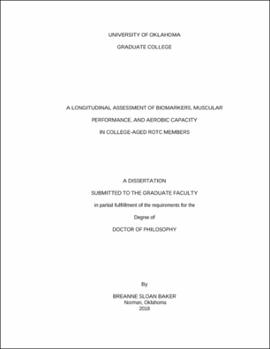| dc.description.abstract | Military personnel engage in vigorous PA, which would suggest higher bone mineral density (BMD) and lower fracture incidence rates; however, bone injuries are common in this cohort. Imaging devices such as DXA and pQCT scanners have been used in addition to serum bone turnover markers (BTM) to describe skeletal responses to military training interventions; however, researchers are investigating novel biomarkers due to poor injury prediction capabilities of BTM. Parathyroid Hormone (PTH) and sclerostin are two markers that have been predictive of fracture in other populations. PTH can cause increased bone resorption and it is a strong predictor of fracture risk in postmenopausal women; however, the investigation of this marker in military populations has produced confounding results. Sclerostin is secreted by osteocytes and is also a marker of bone resorption; however, to date very few studies have investigated the marker’s response to longitudinal exercise in humans. Purpose: The purpose of this study was to determine the effects of an eight week military training intervention on PTH and sclerostin serum concentrations, and aBMD of the total body, dual femur, and lumbar spine, and bone geometry of the tibia, in healthy, college-aged USMC and Naval Reserve Officers’ Training Corps (ROTC) members as compared to a matched control group. A secondary purpose was to determine the relationship between PTH and sclerostin and bone variables. Lastly, group differences in body composition, upper and lower body muscular strength and power measures, and aerobic fitness and their relationships to PTH and sclerostin serum concentrations were examined. Methods: Eighteen college-aged ROTC members were matched for sex, age (±2yrs), and body mass (±5lbs) to physically active controls. ROTC participants engaged in an eight week training intervention, while controls made no changes to their physical activity. Total body areal BMD (aBMD) and body composition were measured by DXA at the pre, mid, and post testing periods. Regional aBMD of the lumbar spine and hips were measured by DXA at the pre and post testing periods. Volumetric BMD (vBMD) of the non-dominant tibia was measured by pQCT at the pre and post testing periods. Serum PTH and sclerostin were assessed from pre and post blood draw using commercial ELISA kits. Lastly, measures of muscular strength and power were tested at the pre, mid, and post testing periods while aerobic capacity was tested pre and post intervention. Results: Both groups decreased total body and regional fat mass (all p≤0.047) while only ROTC participants exhibited significant increases in dominant femoral neck, and dominant total hip aBMD and BMC (all p≤0.033) after the eight week intervention. No consistent group or time differences were found for pQCT variables or biomarker responses. ROTC members started and ended the intervention with greater relative VO2 peak measures and also increased relative VO2 peak significantly more than controls (time effect p=0.007; group effect p=0.014). At both time points serum sclerostin demonstrated strong positive correlations with aBMD, vBMD, and performance measures in the ROTC group. Conclusion: An eight week military training intervention did not result in skeletal changes suggestive of increased risk for injury as compared to a matched control group. In fact the intervention resulted in greater aBMD of the lumbar spine and hip regions in ROTC members. Serum biomarker responses were not significantly different over time; however, sclerostin may provide additional information regarding skeletal changes in this cohort. | en_US |
